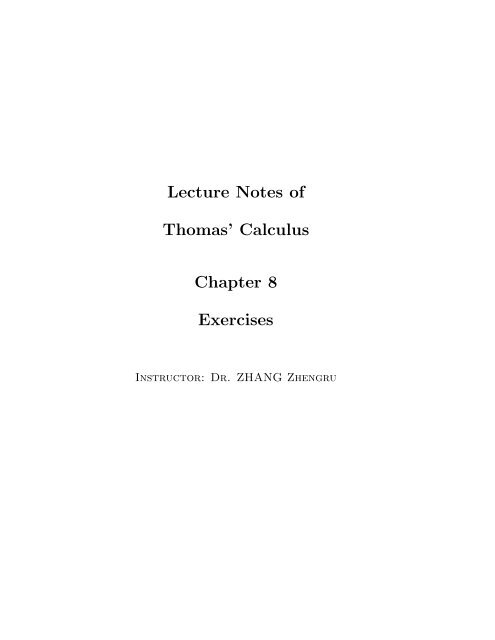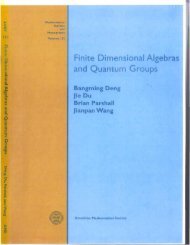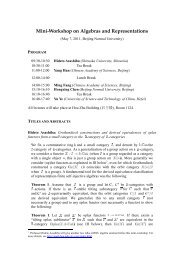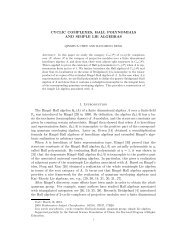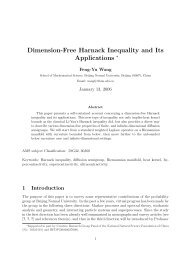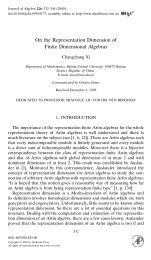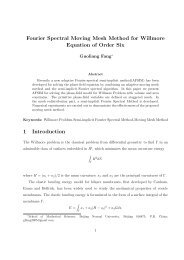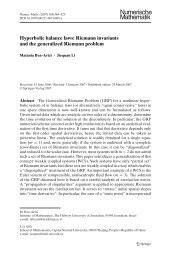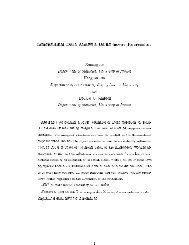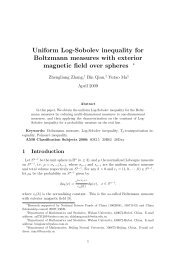Lecture Notes of Thomas' Calculus Chapter 8 Exercises
Lecture Notes of Thomas' Calculus Chapter 8 Exercises
Lecture Notes of Thomas' Calculus Chapter 8 Exercises
Create successful ePaper yourself
Turn your PDF publications into a flip-book with our unique Google optimized e-Paper software.
<strong>Lecture</strong> <strong>Notes</strong> <strong>of</strong><br />
Thomas’ <strong>Calculus</strong><br />
<strong>Chapter</strong> 8<br />
<strong>Exercises</strong><br />
Instructor: Dr. ZHANG Zhengru
<strong>Lecture</strong> <strong>Notes</strong> <strong>of</strong> <strong>Chapter</strong> 9-<strong>Exercises</strong> Page 1<br />
OUTLINE<br />
• Series and Partial Sums<br />
• Geometric Series<br />
• Divergence Series<br />
• nth-Term Test for Divergence<br />
• Adding or Deleting Terms<br />
• Reindexing<br />
• Combing Series<br />
EXERCISES<br />
1. Determine convergence or divergence<br />
(a)<br />
(b)<br />
(c)<br />
(d)<br />
∞∑<br />
n=1<br />
∞∑<br />
n=1<br />
(n!) 2<br />
2n 2<br />
diverges<br />
n cos nπ<br />
3<br />
2 n converges absolutely<br />
∞∑<br />
(−1) n n ln n + 1 converges conditionally<br />
n<br />
∞∑<br />
(<br />
sin 1 )<br />
2n − sin 1<br />
converges absolutely<br />
2n + 1<br />
n=1<br />
n=1<br />
2. Find the sum<br />
(a)<br />
(b)<br />
(c)<br />
∞∑<br />
n=1<br />
∞∑<br />
n=1<br />
∞∑<br />
n=1<br />
x n<br />
n(n + 1)<br />
⎧<br />
⎨ 1 + ( 1 − 1) ln(1 − x) x ∈ (−1, 0) ∪ (0, 1)<br />
x<br />
s(x) =<br />
⎩ 0 x = 0<br />
n 2<br />
n!2 (Hint: consider s(x) = ∑ ∞<br />
n 2<br />
n n! xn s( 1 2 ) = 3 √ e)<br />
4<br />
n=1<br />
2n − 1<br />
2 n (Hint: consider (s(x) =<br />
∞∑<br />
n=1<br />
2n − 1<br />
2 n x 2n−2 s(1) = 3)
<strong>Lecture</strong> <strong>Notes</strong> <strong>of</strong> <strong>Chapter</strong> 9-<strong>Exercises</strong> Page 2<br />
(d) π − π3<br />
3! + π5<br />
5! − · · · + (−1)n π 2n+1<br />
2(n + 1)! + · · ·<br />
(d) 1 −<br />
(f) 1 + ln 2 +<br />
π2<br />
9 · 2! + π4<br />
81 · 4! − · · ·<br />
(ln 2)2<br />
2!<br />
+ · · · + (ln2)n<br />
n!<br />
+ · · ·<br />
3. Find Fourier Sine and Cosine series for<br />
⎧<br />
⎨ 1 0 ≤ x ≤ h<br />
f(x) =<br />
⎩ 0 h < x ≤ π<br />
4. Find the following sums<br />
σ = 1 + 1 2 2 + 1 3 2 + 1 4 2 · · ·<br />
σ 1 = 1 + 1 3 2 + 1 5 2 + 1 7 2 · · ·<br />
σ 2 = 1 2 2 + 1 4 2 + 1 6 2 · · ·<br />
σ 3 = 1 − 1 2 2 + 1 3 2 − 1 4 2 · · ·<br />
Solution:<br />
Consider the Fourier series generating by the following function<br />
⎧<br />
⎨ −x −π ≤ x < 0<br />
f(x) =<br />
⎩ x 0 ≤ x ≤ π<br />
The Fourier coefficients are as following<br />
⎧<br />
a n = 1 ∫ π<br />
⎨ − 4 n = 1, 3, 5, · · ·<br />
n<br />
f(x) cosnxdx =<br />
2 π<br />
π −π<br />
⎩ 0 n = 2, 4, 6, · · ·<br />
a 0 = 1 π<br />
∫ π<br />
−π<br />
b n = 0<br />
f(x)dx = π<br />
Thus<br />
f(x) = π 2 − 4 π (cosx + 1 3 cos 3x + 1 cos 5x + · · ·)<br />
3 52 x = 0, f(0) = 0 then<br />
σ 1 = π2<br />
8 = 1 + 1 3 3 + 1 5 2 + 1 7 2 · · ·
<strong>Lecture</strong> <strong>Notes</strong> <strong>of</strong> <strong>Chapter</strong> 9-<strong>Exercises</strong> Page 3<br />
Note that<br />
σ 2 = 1 4 σ = 1 4 (σ 1 + σ 2 )<br />
so σ 2 = σ 1<br />
3 = π2<br />
24 .<br />
Finally, σ = σ 1 + σ 2 = π2<br />
6 and σ 3 = σ 1 − σ 2 = π2<br />
12<br />
5. Find the limit<br />
√<br />
√<br />
2, 2 + √ √<br />
√<br />
2, 2 + 2 + √ 2, · · ·<br />
— END —


